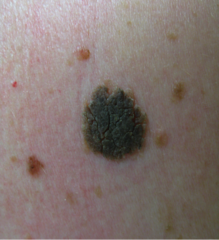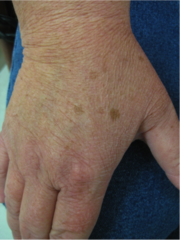Dermatology – Begnin Lesions – Flashcards
Unlock all answers in this set
Unlock answersquestion
Seborrheic keratinosis

answer
Benign superficial (epidermal) growth Common after age 30 Can arise on all body surfaces except palms and soles
question
characteristics of SK's
answer
Often multiple & can be extensive Individual lesions do not go away SKs begin to appear during and after the fourth decade and continue to arise throughout life **Contrast this with nevi, which typically appear in the first three decades of life A new nevus at age 50 should raise suspicion of melanoma
question
variations of SK's

answer
Color can vary from black to tan to white to pink Texture can vary from velvety to verrucous (wart-like)
question
how can i tell if lesion is SK?
answer
SKs are superficial epidermal growths. They always have a **stuck-on quality, like a glob of wax smushed onto the skin **If you are in doubt of the diagnosis, try gently picking at or scratching the lesion. It may crumble, flake, or lift off, revealing that superficial waxy character Also, take a look around at the patient's other growths - Does the lesion look like it's neighbors? Always pay attention to "the ugly duckling" - the lesion that appears different from the rest. When in doubt, biopsy or refer.
question
what do you do about them?
answer
Though harmless, SKs can occasionally become irritated or can be cosmetically bothersome When necessary, SKs may be curetted, lightly frozen or electrodessicated If picked off or curetted, SKs will leave a pink moist base with minimal bleeding
question
tiny SK's on darker skin types in cheeks and temples?

answer
Dermatosis papulosa nigra
question
tx for dermatosis papulosa nigra?
answer
Why not liquid nitrogen? Freezing could cause unsightly hypopigmentation Melanocytes are very sensitive to cold Which "treatment" might you choose? Very light electrodessication is often safest (use of electric current to cause superficial destruction)
question
variant of SK's?

answer
Stucco keratoses - small white-gray SKs pepper dorsal feet and ankles of older fair-skinned individuals.
question
what are acrochordons?

answer
fleshy papules arise in axillae, neck, groin, and eyelids Skin colored to brown Often pedunculated
question
what causes acrochordons?
answer
Genetics, obesity, friction may all play a role. Like acanthosis nigricans, skin tags can be a marker for insulin resistance.
question
tx for acrochordons?
answer
Methods for elective removal include: Snipping (use pressure or aluminum chloride for any bleeding) Liquid nitrogen (for lighter skin types) Electrodessication Occasionally skin tags will outgrow their blood supply or become torsed such that they necrose and fall off on their own
question
what is a cherry angioma?

answer
Majority of people get these starting around age 30 Highest concentration on the trunk Will go away on its own and more will occur
question
what is a dermatofibroma?

answer
benign spindle cell dermal proliferation that looks like wad of scar tissue under the microscope Firm, scar-like texture, in combination with history, is the give-away clue to diagnosis **Peripheral rim of darkening pigment is common If you pinch on either side of a dermatofibroma, it tends to dimple down due to that scar-like tethering of the dermis - "the dimple sign" Often on the legs, especially women Can be multiple Possibly due to minor unrecognized skin insults
question
what is solar lentigo?

answer
The solar lentigo, AKA "sun spot", "age spot", or "liver spot" is due to sun damage, but is not cancerous or precancerous No treatment required, however... Extensive solar lentigines reflect history of UV exposure, and therefore can identify patients at risk for skin cancer
question
what is sebaceous hyperplasia?

answer
Sebaceous gland (i.e. oil gland) overgrowth Hence the yellow color Umbilication due to gland growth around a central hair follicle Removal is not medically required and is cosmetic
question
differentiate between sebaceous hyperplasia and bcc?
answer
Yellow color, umbilication, and multiple similar papules help identify sebaceous hyperplasia BCC tends to be solitary and more friable (bleeds, scabs) - also more pearly translucent, often with telangiectasia Biopsy or referral may be necessary
question
what is keloid? tx?

answer
overgrowth of scar tissue beyond the original scar site Genetic influence (most common in African-Americans) more common on upper trunk and earlobes Excision alone is a bad idea! Expect the keloid to recur, even larger Topical steroid is usually ineffective Intralesional steroid and/or referral is best
question
what are epidermal inclusion cysts?

answer
mobile subcutaneous nodule, often with an overlying punctum Although sometimes referred to as "sebaceous cysts", EIC's actually arise from hair follicles, not oil glands Debris (dead skin cells, oil, etc.) collects within a sack May discharge foul smelling cheesy white material Benign and require no treatment However, when traumatized, EICs may rupture in the skin, creating an abscess which may require incision & drainage (I&D) Unlike a bacterial abscess, ruptured EICs tend to be sterile and do not require oral antibiotics. Presence of a preceding EIC differentiates from bacterial abscess. Both types of abscesses require I&D.
question
what is a milia? tx? milia in children?

answer
tiny epidermoid cyst Often on the face and therefore cosmetic concern Nearly half of newborns have a few milia, and these DO tend to resolve, but when milia arise on the adult face, they will often persist Nick the surface with an 11 blade or an 18 gauge needle, then gently express the entire cyst, lining and contents. Dress with a dab of petrolatum.
question
what are pilar cysts? differentiate from EIC? tx?

answer
Slowly enlarging over months to years Firm, mobile subcutaneous nodules, lacking punctum Do not discharge any material Compared to an EIC, less likely to rupture or get inflamed Nearly always on the scalp Incise the overlying skin, dissect out and express the glistening, firm, white pilar cyst, and sew the defect closed
question
what are lipomas? tx?

answer
soft, subcutaneous nodule, lacking any overlying skin change other similar soft to rubbery mobile subcutaneous nodules on arms and legs Texture is your clue - lipomas feel like what they are...collections of fat under the skin Growth usually stabilizes at a few cm diameter Often solitary, frequently on the trunk and proximal extremities When familial (autosomal dominant), lipomas tend to be multiple and begin in early adulthood Occasionally lipomas can be tender



